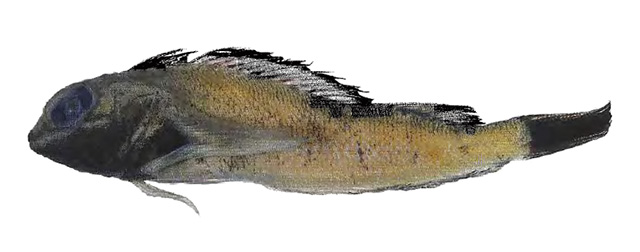| Tripterygiidae (Triplefin blennies), subfamily: Tripterygiinae |
| 4.08 cm SL (male/unsexed); 3.32 cm SL (female) |
|
demersal; marine; depth range 0 - 6 m |
| Western Central Pacific: Japan, Philippines and Guam. |
|
Dorsal spines (total): 16-18; Dorsal soft rays (total): 11-11; Anal spines: 1-1; Anal soft rays: 19-20; Vertebrae: 37-37. Distinguished by the following characters: 5-8 symphyseal mandibular sensory pores; second dorsal fin spines XIII-XIV; last pleural ribs on vertebral centrum 11, vertebrae 11+ 26 = 37; nape naked (Ref. 9849); black lower half of head; bright blue stripe extending from anterior part of upper lip to preopercular margin through ventral margin of orbit; dorsal fins black distally; central part of pectoral fin base black; entire caudal fin black (Ref. 95023). Description: Dorsal fin III, + XIII-XV + 11; anal fin I, 19-20; pectoral rays 0-1 + 8-9 + 7 = 16-17; pelvic fin I, 2; caudal rays 13, branched 9, procurrent 16-20. Vertebrae 11 + 26 = 37. Mandibular pores 5-8 + 5-8 + 6-8. Gill rakers 7-8 on first arch. In preservative, overall brownish or tan; females paler than males. Orbital with cirrus. Scaleless head, nape, first dorsal fin base, pectoral-fin base, and bell y. LL continuous, pored scales 23-31. Scales ctenoid, largest (double-sized) below lateral line and posterior of pectoral-fin base. In preservative, overall pale yellow, tan or brown, possibly red in life with neon-blue band below the eye, from jaw to opercle, body with 4-5 stripes from dorsal-fin base down to middle depth of body. Male head, chest and pectoral-fin base masked darkly; females uniformly pigmented overall. Fins translucent; dorsal-fin margin dark; pectoral-fin base with triangular spot; caudal fin black in males, but in females translucent with four dark vertical stripes (Ref. 9849, 52308, 90102). |
| Adults are found among rocky boulders and in surge channels to a depth of about 6 m (Ref. 9849). Eggs are hemispherical and covered with numerous sticky threads that anchor them in the algae on the nesting sites (Ref. 240). Larvae are planktonic which occur primarily in shallow, nearshore waters (Ref. 94114). |
|
Least Concern (LC); Date assessed: 03 May 2010 Ref. (130435)
|
| harmless |
Source and more info: www.fishbase.org. For personal, classroom, and other internal use only. Not for publication.

